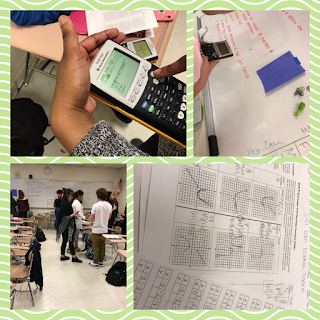You may be wondering... How is the Math 3 Version of the Piecewise Scavenger Hunt different than the AFM Version that RJ created? Honestly, I doubt there is a difference, except in the approach with the students. Anyone who has taught piecewise functions understands that the struggle is real - students truly have a hard time seeing the "pieces" of the function, so every little bit helps!
My colleague (and co-author of Girl Math), RJ, teaches piecewise functions at a level higher than the one I teach. Therefore, she uses this activity as more of a review while my approach is more of a learning experience - trying to get the kiddos interested and collaborating with rich discussion (not that RJ doesn't share these goals!) Anyway, can you really have too many piecewise resources? Uh, no.
 In order to create my graphs, I went to Desmos. I can only assume that if you're reading a blog about teaching math, you already know the awesomeness that is Desmos. Unfortunately, at the time of creating this activity, I did not know how to create open/closed circles where the graphs are discontinuous. Oh well, we're always learning something new - and it's so much easier in Desmos than creating circles in a Word document (how antiquated, right?).
In order to create my graphs, I went to Desmos. I can only assume that if you're reading a blog about teaching math, you already know the awesomeness that is Desmos. Unfortunately, at the time of creating this activity, I did not know how to create open/closed circles where the graphs are discontinuous. Oh well, we're always learning something new - and it's so much easier in Desmos than creating circles in a Word document (how antiquated, right?).
I hope you enjoy this activity, I truly think it helped my students get more comfortable with piecewise functions - not to mention translations in general.
~SSB
My colleague (and co-author of Girl Math), RJ, teaches piecewise functions at a level higher than the one I teach. Therefore, she uses this activity as more of a review while my approach is more of a learning experience - trying to get the kiddos interested and collaborating with rich discussion (not that RJ doesn't share these goals!) Anyway, can you really have too many piecewise resources? Uh, no.
 In order to create my graphs, I went to Desmos. I can only assume that if you're reading a blog about teaching math, you already know the awesomeness that is Desmos. Unfortunately, at the time of creating this activity, I did not know how to create open/closed circles where the graphs are discontinuous. Oh well, we're always learning something new - and it's so much easier in Desmos than creating circles in a Word document (how antiquated, right?).
In order to create my graphs, I went to Desmos. I can only assume that if you're reading a blog about teaching math, you already know the awesomeness that is Desmos. Unfortunately, at the time of creating this activity, I did not know how to create open/closed circles where the graphs are discontinuous. Oh well, we're always learning something new - and it's so much easier in Desmos than creating circles in a Word document (how antiquated, right?).I hope you enjoy this activity, I truly think it helped my students get more comfortable with piecewise functions - not to mention translations in general.
~SSB

Comments
Post a Comment